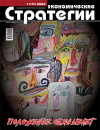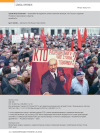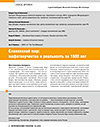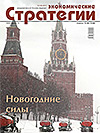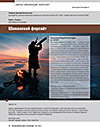The USSR Collapse in the Light of Fractal Cyclical Nature of the Russian History
DOI: https://doi.org/10.33917/es-5.185.2022.114-119
The article proposes an approach to the problem of the USSR collapse within the framework of interdisciplinary direction of megahistory and global evolution, where the USSR collapse itself turned up to be a bifurcation of the scale invariance of the producing economy history. Its final world cycle gives a picture of periods that completely coincides with the written history of Ancient Russia — the Russian Empire — the USSR.
References:
1. Kuzyk B.N., Ageev A.I., Dobrocheev O.V., Kuroedov B.V., Myasoedov B.A. Rossiya v prostranstve i vremeni (istoriya budushchego) [Russia in Space and Time (History of the Future)]. Moscow, INES, 2004, 336 p.
2. Kul’pin E.S. Geneticheskie kody tsivilizatsii. Sotsioestestvennaya istoriya. Genezis krizisov prirody i obshchestva v Rossii [Genetic Codes of Civilizations. Socionatural History. Genesis of Crises of Nature and Society in Russia]. Vyp. 4. Moscow, Moskovskii litsei, 1995, pp. 32–35.
3. Kul’pin E.S. Sotsioestestvennaya istoriya. Ot metoda — k teorii, ot teorii — k praktike [Socionatural History. From Method to Theory, From Theory to Practice]. Volgograd, Uchitel’, 2014.
4. Gridchin I.V. Sotsioestestvennaya istoriya kak megatsikl istorii chelovechestva [Socionatural History as a Megacycle of Human History]. Istoriya i sovremennost’, 2017, no 1, pp. 177–183.
5. Gridchin I.V. Troichnyi ritm faz sotsial’noi megaistorii. Ego prikladnoe znachenie dlya sistemnogo analiza i prognozirovaniya. Evolyutsiya. Patterny evolyutsii [The Ternary Rhythm of the Phases of Social Megahistory. Its Applied Significance for System Analysis and Forecasting. Evolution. Evolution Patterns]. Volgograd, Uchitel’, 2018, pp. 139–156.
6. Kul’pin E.S. Zolotaya Orda: sud’by pokolenii [Golden Horde: Destinies of Generations]. Vyp. XXVIII. Moscow, INSAN, 2006. (Seriya: Sotsioestestvennaya istoriya. Genezis krizisov prirody i obshchestva v Rossii.)
7. Bzhezinskii Z. Soedinennye Shtaty prevyshe vsego. Mezhdunarodnye posledstviya 1989 goda [The United States Above All. International Consequences of 1989]. Nezavisimaya gazeta, 1999, November 24.
8. Bulkin V.A., Dubov I.V., Lebedev G.S. Arkheologicheskie pamyatniki Drevnei Rusi IX–XI vekov [Archaeological Sites of Ancient Russia of the 9th–11th Centuries]. Leningrad, LGU, 1978.
9. Gridchin I.V. Raspad SSSR [Collapse of the USSR]. Priroda i chelovek. XXI vek, 2017, no 4, pp. 19–22.
10. Slavkina M.V. Triumf i tragediya. Razvitie neftegazovogo kompleksa SSSR v 1960–1980-e gody [Triumph and Tragedy. Development of the Oil and Gas Complex of the USSR in the 1960s–1980s]. Moscow, MAKS-Press, 2002.


